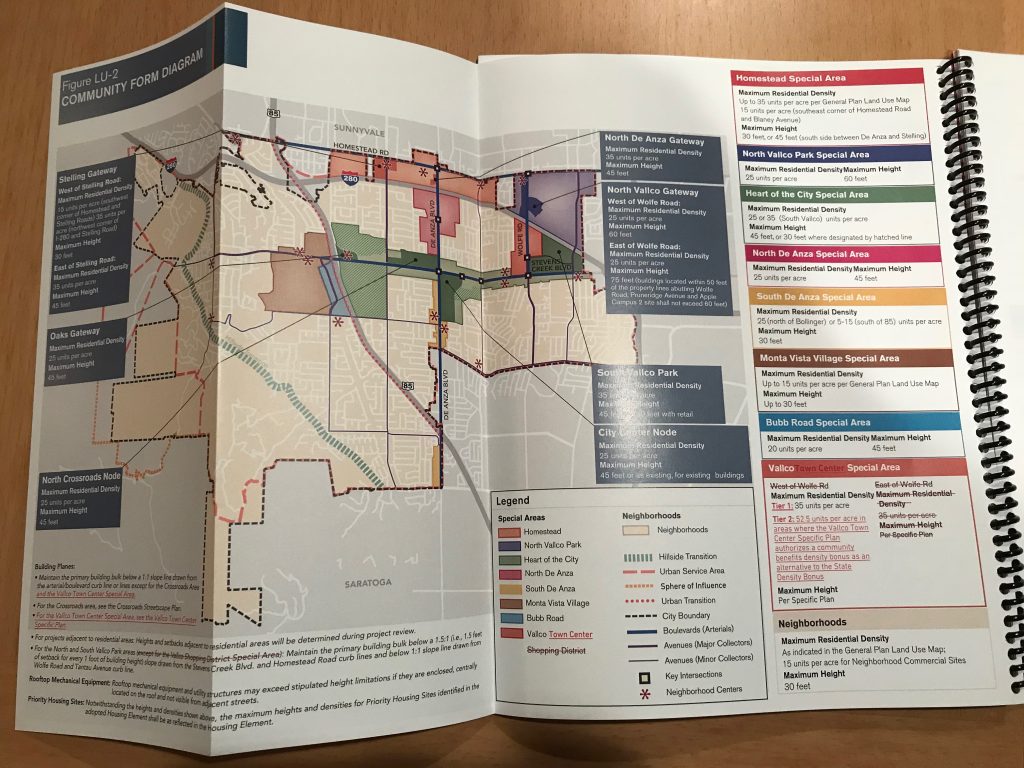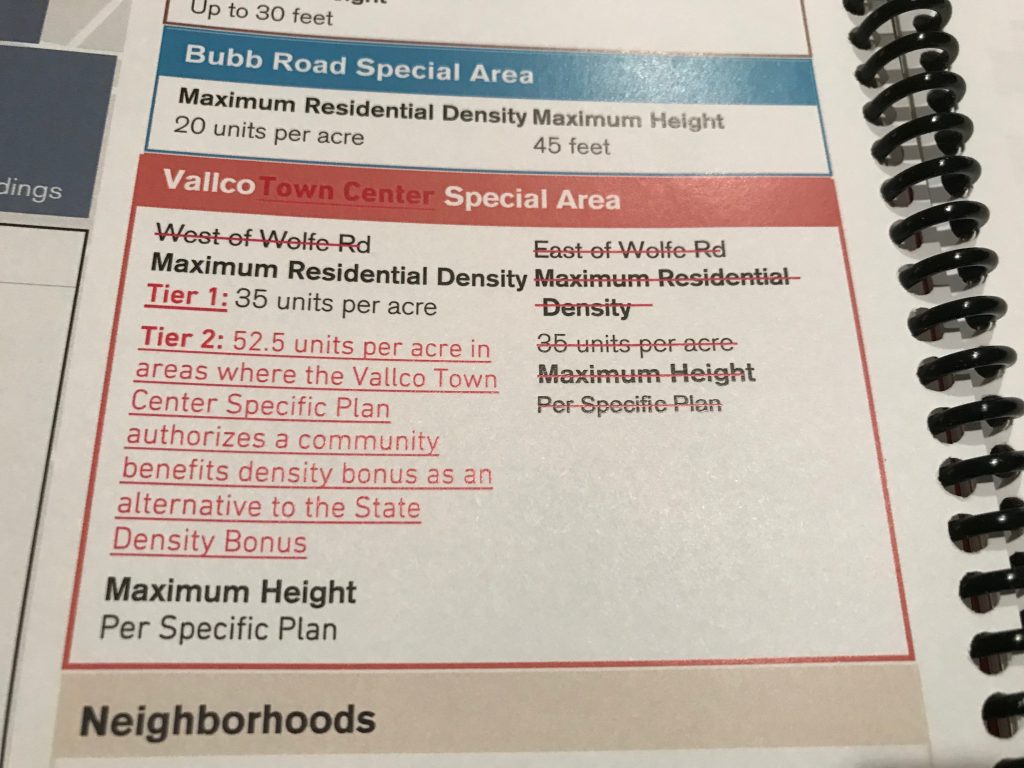(Archived, May, 2022)
Vallco developer SHP has recently updated their SB 35 development plan and renamed it “The Rise.” It contains several buildings with height of over 200 ft — looking down on the single-family homes. Many residents don’t understand why this is allowed in Cupertino. Doesn’t the General Plan prevent such monstrosity right next to residential housing? To answer this question, let’s take a look at the history of Vallco rezone and how this all started with the pro-developer Cupertino city council in 2014.
Step 1: Cloak and dagger
On December 2nd, 2014, the Cupertino city council met to discuss two important topics, GPA (General Plan Amendment) and Housing Element.
The General Plan is the city’s development constitution and overrides other zoning laws. It provides high-level limits on building height and density. More detailed regulations are specified in the Municipal Codes and must not violate the General Plan.
In order to accommodate population increase, the General Plan had already allowed increased height (up to 4 stories) and density for the commercial areas along Stevens Creek Blvd. For Vallco, the height limit was up to 6 stories.
But that figure falls far short of satisfying Sand Hill’s (Vallco developer) greed. During the December 2nd, 2014 meeting (continued on December 3rd and finished in at 3:16 am December 4th), the city council went even further, erasing the building height and building density for Vallco and secretly replacing it with “TBD”, which means that you can let Developers modify the building height and density by themselves. With sufficient under-the-table benefits, Sand Hill is the only developer that is able to build to the sky in Cupertino. No other developer could have ever imagined that the game can be played to this extreme. Even in other California cities, no one dares to eliminate building height limit and let developers fill in the blanks. The audacity of Cupertino’s pro-developer Council is truly extraordinary. And the residents just couldn’t imagine that such hidden loophole is even possible because their imagination is limited by honesty, integrity, and ethic. Apparently, the Cupertino city council of December 2014 had no problem crossing that boundary.
Moreover, the residents were tricked by a blatant lie. Many residents were concerned about development at Vallco and throughout the city. They attended the December 2nd and 3rd council meeting in huge numbers. Around midnight of December 4th, the city council said that they would not vote on the General Plan that night. That declaration prompted the residents to go home to sleep. But around 2 am on December 4th, the city council actually voted to allocate 2 million sq. ft. of office space and removed height limit at Vallco. The vote that was not supposed to happen was passed 4:1. Only Darcy Paul opposed. Gilbert Wong, Rod Sinks, Barry Chang, and Savita Vaidhyanathan, all voted in favor. That was the beginning of non-ending corruption related to Vallco development.


Step 2: Morally and ethically unrepentant
After discovering this obvious loophole in the GPA, hundreds of residents asked the city council to correct their error. The residents marched several times in 2015. They wrote emails to the city council and spoke at council meetings. Without any repentance, the city council totally ignored the residents and even characterized the residents as rebels. The city council accused the residents of not understanding anything but only complaining and hindering the development of the city. And despite hundreds of protesters, the city council stubbornly claimed that there are just a few extremists in a city of tens of thousands of people and that the silent majority fully supports the city council.
Step 3: Publicly silencing the opposition
Over the next two years, concerned residents organized and formed Better Cupertino. After two years of unsuccessful protests, Steven Scharf, a founding member of Better Cupertino, won a seat on the city council in the November 2016 election. But Steven Scharf and Darcy Paul only have two votes and were unable to reverse the situation suppressed by the majority. Therefore, to fill the loopholes in the General Plan, we had to wait until the 2018 election, when more resident-focused city council are elected.
However, in the fall of 2017, a state law with huge beneficial impact for Vallco developer, SB35, was passed. Under the disguise of easing California’s housing shortage, the law says that a development project can bypass city council approval if housing is 2/3 of the total project and half of housing is reserved for low-income residents. SB35 does say that the development project must conform to the city’s General Plan. But guess what? Cupertino’s General Plan doesn’t have any height restriction for Vallco — a unique preferential treatment in California.
To this end, Steven Scharf and Darcy Paul urged the city council to fill the loopholes in the General Plan before SB 35 took effect on January 1, 2018. Nearly 100 residents went to the council meeting to express their support for closing the loophole. However, the other three councilmembers not only pretended not to hear, but even before Darcy Paul was about to become mayor, they publicly voted to pass a mayor’s gag order, removing the mayor’s independent authority to add to the council meeting agenda. This way, three councilmembers can silence Darcy Paul and Steven Scharf and prevent the discussion of Vallco’s zoning loophole in 2018.
Step 4: Reckless risk
On January 1, 2018, state law SB 35 took effect. Unsurprisingly, the Vallco developers quickly came up with a Vallco SB 35 plan. While the plan won’t be voted on by the city council, the city will at least have to approve compliance with existing laws. During the review process, city lawyer Randolph Hom discovered that the hasty plan had many flaws and could result in legal trouble for the city. Out of professional ethic, he refused to sign off on the plan right away and hoped that the developer would amendment the plan in order to protect the city’s interests and avoid legal trouble.
However, sensing the increasing support for Better Cupertino, the pro-developer forces know that if the project must be approved before November 2018. With the support of 3 councilmembers, City Manager David Brandt decided to silence City Attorney Randolph Hom. He skipped the City Attorney approval step and approved the Vallco SB35 application. This kind of reckless behavior and risk is also unheard of in other cities. Worse yet, the 3 councilmembers took even more reckless action by firing Randolph Hom. This resulted in Cupertino paying unspecified amount for wrongful termination.
In November 2018, Liang Chao and Jon Willey also won city council seats. But it was too late to rectify the intentional mistakes that led to Vallco SB 35 plan. But it does highlight the need for resident-focus councilmembers to protect the interest of the city and its residents. We can never allow future developers to plant loopholes that enable out-of-control and limitless development.
In addition, Better Cupertino filed a lawsuit against the developer in 2019, accusing the Vallco SB 35 plan of being written too hastily and not fully complying with the state law SB 35. But the final ruling of the court is that parts of the plan complies with state. If there are parts that are questionable, David Brandt’s signature implies that the city believes compliance. Therefore, the plan is valid.
That is why the Vallco developer can build over 20 stories. None of the other SB35 plans allows the developer to build as high as it wants.
Now, Vallco developer is floating a new propaganda — Cupertino must overthrow the resident-focused city council and let the Vallco development finish quickly. If not, everything will stop. This statement is too naive. In reality, the corruption will just start up again if pro-developer councilmembers are elected. After Vallco “successfully exploited the loopholes”, other developers are eager to attack the General Plan by buying the city council. If the residents do not elect resident-focused city council, every commercial development in the city may be approved with unlimited building heights and other developer-specified parameters.